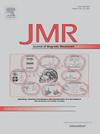用傅立叶合成法设计垫片线圈。
IF 1.9
3区 化学
Q3 BIOCHEMICAL RESEARCH METHODS
引用次数: 0
摘要
提出了一种产生“垫片”的新方法,即球谐场。这项技术依赖于一个轴向排列的圆柱体表面上正弦方位电流的空间频率与它们产生的球谐轴向磁场的程度之间的直接对应关系。正弦电流波形至少以最大所需度/频率的两倍采样,然后将电流采样施加到相同数量的相同导电电弧上,在相同的轴向位置,均匀分布在一个环中。然后,在不同的轴向位置和适当的正弦电流幅值处重复使用该构件,以允许小于或等于最大值的任何程度的谐波混合;最大顺序由轴向位置的数量决定。计算是分析性的,除了功率消耗或均方电流的数值最小化,以及轻微末端效应的校正。访问作者的Mathematica笔记本,可以帮助概念和计算提供。该设计拥有比目前正常的更高阶和度的更准确的生成的承诺,并且易于与箔或带状电缆制造;通常与结构相关的复杂性基本上转移到外部电子设备上。本文还介绍了一种新型的、概念性的、具有高效率和顺应性的电流驱动器。本文章由计算机程序翻译,如有差异,请以英文原文为准。
Shim coil design by Fourier synthesis
A new method of creating “shims”, i.e. spherically harmonic fields, is proposed. The technique relies on a direct correspondence between the spatial frequency of sinusoidal azimuthal currents on the surface of an axially aligned cylinder and the degree of the spherically harmonic, axial magnetic fields they create. The sinusoidal current waveform is sampled at at least twice the maximum desired degree/frequency, and the current samples are then applied to the same number of identical conducting arcs, at the same axial position, evenly distributed in a ring. Repetition of this building block at differing axial positions and with appropriate sinusoidal current amplitudes is then used to allow a mix of harmonics of any degree less than or equal to the maximum; the maximum order is determined by the number of axial positions. Calculations are analytical, apart from numerical minimisation of power consumption or mean square current, and correction of minor end effects. Access to the author's Mathematica Notebooks that may help with concepts and calculations is provided. The design holds the promise of more accurate generation of higher orders and degrees than is currently normal, and of easy fabrication with either foil or ribbon cable; the complexity usually associated with construction is essentially transferred to exterior electronics. A novel, conceptual current driver with high efficiency and compliance is also mentioned.
求助全文
通过发布文献求助,成功后即可免费获取论文全文。
去求助
来源期刊
CiteScore
3.80
自引率
13.60%
发文量
150
审稿时长
69 days
期刊介绍:
The Journal of Magnetic Resonance presents original technical and scientific papers in all aspects of magnetic resonance, including nuclear magnetic resonance spectroscopy (NMR) of solids and liquids, electron spin/paramagnetic resonance (EPR), in vivo magnetic resonance imaging (MRI) and spectroscopy (MRS), nuclear quadrupole resonance (NQR) and magnetic resonance phenomena at nearly zero fields or in combination with optics. The Journal''s main aims include deepening the physical principles underlying all these spectroscopies, publishing significant theoretical and experimental results leading to spectral and spatial progress in these areas, and opening new MR-based applications in chemistry, biology and medicine. The Journal also seeks descriptions of novel apparatuses, new experimental protocols, and new procedures of data analysis and interpretation - including computational and quantum-mechanical methods - capable of advancing MR spectroscopy and imaging.

 求助内容:
求助内容: 应助结果提醒方式:
应助结果提醒方式:


